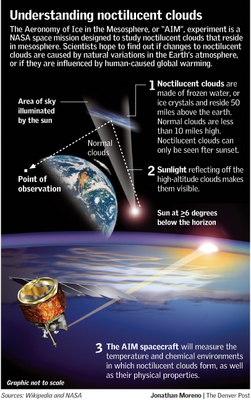
|
| ©Denver Post |
| This hauntingly beautiful noctilucent cloud was photographed over the Juneau, Alaska, ice field in 1998. Once confined to Earth's poles, the clouds have been spotted above Colorado. |
Once confined to Earth's poles, the bizarre clouds have now been spotted above central Colorado, and they appear to be getting brighter and more numerous, too, said David Rusch, a University of Colorado atmospheric scientist.
This month, NASA plans to launch the $110 million AIM (Aeronomy of Ice in the Mesosphere) mission to measure noctilucent clouds and the circumstances in which they form - which may be linked to climate change.
The satellite will measure air temperature and pressure, moisture content and cloud dimensions.
Researchers at the University of Colorado at Boulder will control the satellite, process data and try to understand what some call the planet's most mysterious clouds.

|
| ©Denver Post |
| Graphic explains noctilucent clouds and NASA's mission to study them. |
Noctilucent clouds appear only at night, when their altitude - 50 miles up in the atmosphere - lets them catch sunlight no longer visible from Earth's surface, said James Russell, an atmospheric scientist at Hampton University in Virginia, the NASA mission's principal investigator.
That makes noctilucent - "night-shining" - clouds appear almost iridescent, he said. Most normal clouds are less than 10 miles up.
"They're very beautiful, they look very mysterious, but aside from all that, these clouds are changing in ways we don't understand," Russell said.
Researchers have many ideas about why noctilucent clouds may be growing in number and brightness, and most of them are related to global warming.
The greenhouse gas carbon dioxide, which warms Earth's surface, paradoxically cools the upper atmosphere, CU's Rusch said.
Noctilucent clouds - which are made of ice crystals, not water droplets - need very cold temperatures to form, he said.
In the atmosphere's coldest reaches, there's very little water vapor, a key ingredient for cloud formation, Rusch said.
Observed increases in water vapor in the atmosphere - a consequence of warming - may also make it easier for the clouds to form, he said.
Methane, another powerful greenhouse gas, may also be involved, said Scott Bailey, an engineering professor at Virginia Tech in Blacksburg, Va.
Methane's presence can increase the amount of water in the upper atmosphere, through a complicated chemical dance.
Scientists don't know enough yet to definitively call noctilucent clouds harbingers of climate change, Russell said.
"But right now, we don't have another explanation," he admitted. "We don't have enough information about them. Hopefully, in this mission, we'll be able to get it."



Well, man-made global warming can be ruled out now:
Increased meteor smoke: Noctilucent clouds brightening and spreading south [Link]